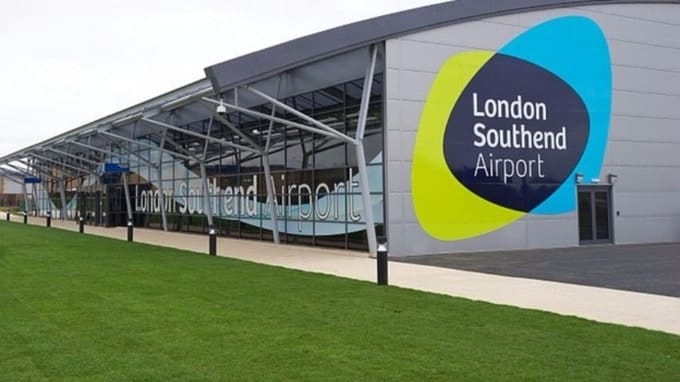The Challenge
London Southend Airport, now part of the London Airports Group, currently sees 1 million passengers passing through the airport per annum. Rated as the best London airport over the last six years by Which? Magazine and the best airport under 3 million passengers in the UK at the AOA Annual Awards, there is a lot of potential for the airport to expand. Initial growth plans aim to raise capacity to 3mpa then 5mpa.
There are some restricting factors for the airport to overcome. There is a limited footprint, particularly at Check-In, Security and Boarding Gates. There are no separate boarding gates at the airport, with boarding gates situated within the International Departure Lounge (IDL). Rapid growth has seen the addition of four new flights at peak time from Summer 2019 from a new airline, Ryanair, operating bigger aircraft. Asset replacement is also taking place, restricting capacity as Hold Baggage Screening (HBS) machines are upgraded to ECAC Standard 3, as well as limited make-up capacity.
AiQ Consulting were asked to carry out an End-to-End Capacity Assessment for the airport, from Kerbside to Boarding Gates. We collected data at every point in the passenger journey and carried out on-site surveys covering operational hours to validate the initial assessment from the airport and then inform on their future growth plans.
The Solution
With our deep knowledge of worldwide airport operations we were able to share best practices and new technologies for any challenge we identified for London Southend Airport. To analyse the passenger journey, we looked at how passengers arrived at the airport, whether this was via taxi, private car through drop off or parking, public transport (bus/coach and rail) and were able to inform the airport about peaks, queues and congestion into the terminal building, check-in and security.
We then validated growth plans for summer 2019 (S19) and winter 2019 (W19), with the new airline and new flight schedule. In S19, we could show that the check-in capacity would breach and security screening would be well above the capacity threshold if the infrastructure remained the same. Boarding gates would also be a restricting factor. Beyond S19, the demand would outgrow the current capacity of London Southend, and growth would be restricted within existing terminal envelope.
The airport currently has traditional static check in desks. With the proposed growth there would be an increase in queues and waiting times, leading to pressures operationally and reduced dwell time in the IDL. This is a loss of commercial revenue as well as an impact on passenger experience. We modelled a check-in infrastructure where the 10 traditional check-in desks are replaced with a two-step check-in process including self-service bag drop. The outcome would lead to an increased capacity within current footprint of the area and would reduce waiting times and queue lengths significantly in comparison with traditional check-in.
However, efficiency at check-in can have an impact on security screening of passengers. We assessed the passenger flow and the staffing patterns in line with proposed changes at check-in and proposed a roving staff roster, load balanced to deal with peaks before and after security. We also modelled introducing e-gates at boarding pass control to increase throughput and reduce long queues.
For the IDL, we were able to inform on the ratio between Food & Beverage and standard seating, with a breakdown of what passengers were sitting where. With the restrictions of 10 stands and six boarding gates all in use at peak times, we identified peaks and associated passenger numbers that would have to be managed.
We gave recommendations for how the airport could approach this. For example, additional capacity could be unlocked within the current footprint by incorporating proposed infrastructure changes at check-in and boarding pass control to meet future demand.
The Benefits
Our expert team provided the airport with an End-to-End model built to run any scenario or assessment to assist them and their future growth plans. Using TransvisionAiRTM, our bespoke demand, capacity and simulation modelling tool, we created clear airport capacity scenario models to communicate our results and enable efficient decision making for our clients.
We provided terminal revision and a critical assessment of the entire terminal. We identified opportunities such as an additional security lane, enhancements in process time, security and check in and eGates, to improve the overall passenger experience and journey with technological advances.
The client could also successfully visualise the pressures the existing infrastructure of the airport was under, as well as the new stress points that proposed growth and new flight schedules would create. From our analysis, they are able to determine their options regarding terminal footprint, the capacity within the existing envelope and the opportunities to extend which we were able to outline.
- Holistic view delivering real value to overall airport operations
- Kerb-to-gate passenger flow and capacity assessment on various scenarios
- Increased capacity utilising existing terminal footplate
- Efficient stakeholder management
- Improved passenger customer service and airport experience
- Integrated technology
- Expert baggage systems knowledge
- Recommendation of new technologies
- Accurate and authoritative validation required for the CEO to make investment decisions
- Improved operational practices
- Recommendations of redesign of the terminal space to optimize retail spend
What the client says
“AiQ Consulting’s strong knowledge of airport operations, particularly for constrained airports, was a great benefit to London Southend. Their accurate and authoritative validation for investment decisions allowed us to visualise where changes can be made, in terms of capacity, footprint and new technology, which will enable us to succeed in our growth plans going forward.”
Willie McGillivray, Chief Operating Officer, London Southend Airport


